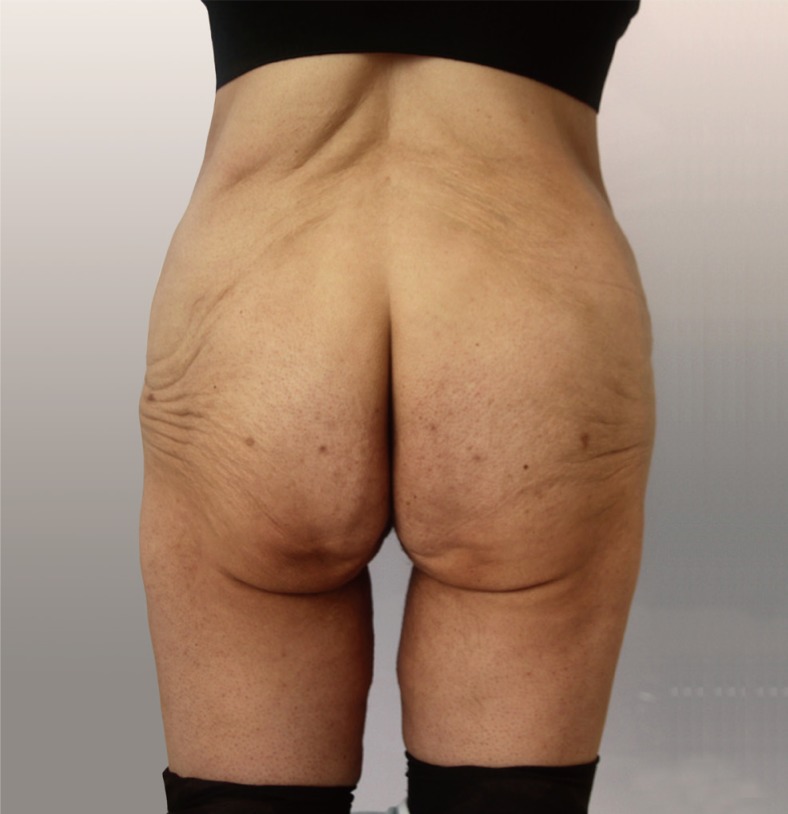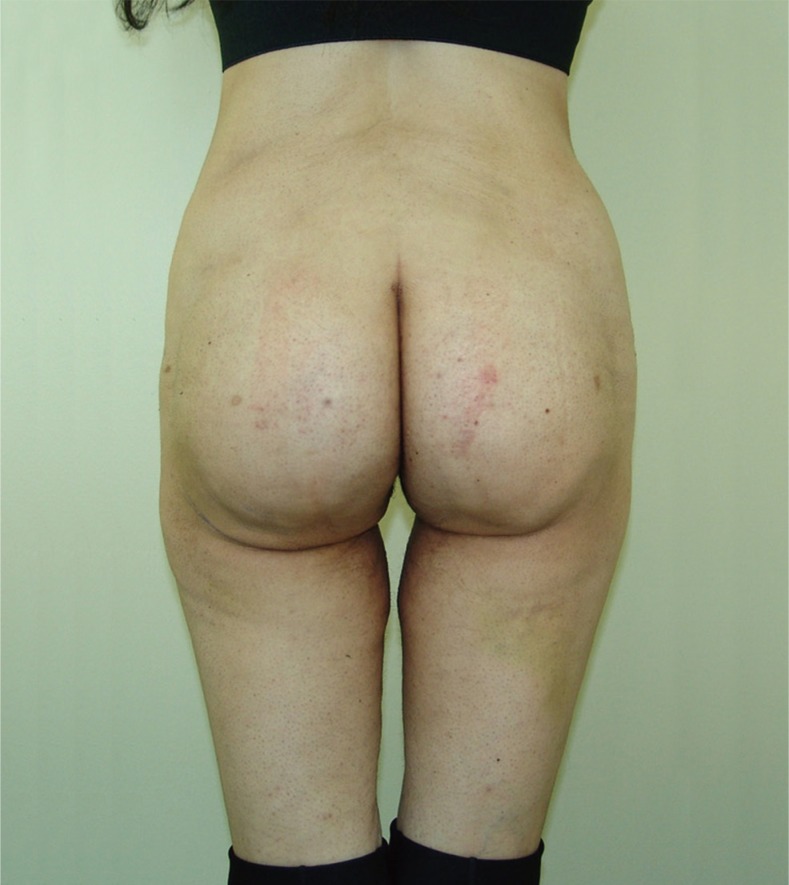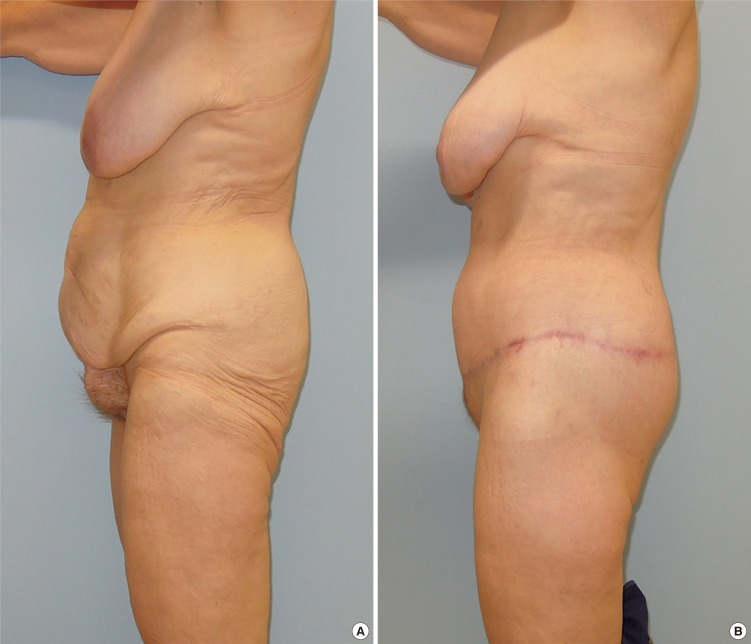Gluteal Reshaping in the Massive Weight Loss Patient
Article information
Dear Editor,
The gluteal region is increasingly becoming an area of attention in body contouring surgery. In particular, in South America, surgical modification of the buttocks is as common as breast procedures [1]. Aesthetic surgery of the buttocks usually involves either augmentation or recontouring, and this may be achieved by liposuction, liposuction in combination with lipotransfer, lifting procedures, gluteal implants, or a combination of these methods. In Europe and Asia, gluteal implants still remain in a state of slumber since the buttock region is not as important a hallmark of beauty as the breasts. This fact accounts for the low number of prosthetic buttock augmentation procedures performed in our country, Austria. However, we do have a large number of patients who have experienced massive weight loss after bariatric surgery. In this patient population, the demand for corrective surgery is high and the patients are often faced with multiple surgeries. Thus, an algorithmic approach in order to treat multiple adjacent areas within one operation is advantageous [2]. In the massive weight loss patient, very often, there is a pronounced lack of projection in the gluteal region (Fig. 1). Therefore, strategies on the best way to lift sagged tissues and to improve the projection of the buttocks have to be taken into consideration. Numerous articles have been published on the possibility of utilizing autologous tissue for augmentation [3,4]. All of these techniques have an inherent need for a large lifting procedure with a resulting long scar. However, as is the case in breast surgery, the ptotic buttocks can also be lifted and rejuvenated with implants alone or with an autologous fat transfer. Both methods have the advantage of avoiding a long scar over the lower back and the added morbidity of a large excisional procedure. In our patient, the gluteal region was definitely improved by implantation of the gluteal implant alone (Fig. 2).

Posterior view of a 38-year-old female patient, who has experienced dramatic weight loss with resulting generalized tissue laxity. She has already undergone a regular abdominoplasty but still complains about residual skin surplus over her lower anterior trunk. Additionally, she displays pronounced sagging skin around the gluteal region for which she seeks improvement.

Early postoperative result after the placement of subfascial, anatomically shaped, 300-mL gluteal implants. There is definitive improvement of the projection as well as skin laxity in the posterior view.
Since excisional body contouring procedures have a rather high incidence of postoperative wound complications [5], they might be troublesome in the early postoperative period if a large excisional procedure is combined with an implant. In particular, in the region of the rima ani, wound healing is impaired if the scar is blended caudally for an enhanced aesthetic appearance. As is well known with breast implants, an infection may lead to a necessary explantation of the infected implant. Due to the rather high incidence of wound healing issues when combining an implant with a large excisional and lifting procedure, delayed wound healing with secondary wound infection and prolonged drainage must be kept in mind.
Therefore, we want to propose that augmentative gluteal reshaping in the massive weight loss population should be planned in a staged manner, starting with implants alone as the first option. An autologous fat transfer is another excellent option ("Brazilian buttock lift"), particularly if liposuction is an integral part of the planned operation. The liposuction procedure can further augment the aesthetic outcome of the operation. However, one possible drawback of this approach is the uncertainty of the amount of fat that will be reabsorbed. Even when adhering to the current "gold standard" techniques in fat harvesting and handling, there is definitively some degree of volume loss over time with an autologous fat transfer.
Another alternative to the implant augmentation of the buttocks is gluteal autoaugmentation. Most articles focusing on the buttock region in a massive weight loss patient propose some form of autoaugmentation by using the surplus tissue. However, in a certain type of patient, this form of augmentation may not be possible due to the pronounced weight loss with lacking tissue volume. Additionally, creating flaps and burying them subcutaneously can also lead to problems such as tissue palpability, partial fat tissue necrosis, or loss of volume. However, buttock autoaugmentation should always be considered the first option in this patient population (Fig. 3). The combination of gluteal implants with a large lifting procedure should be reserved for special cases since this procedure has a definite learning curve and the added morbidity of two procedures. Table 1 lists our algorithmic approach and indications for gluteal reshaping in the massive weight loss patient.

(A, B) Preoperative and 1-year postoperative lateral views of a female massive weight loss patient after a lower bodylift with gluteal autoaugmentation using deepithelialized adipose flaps. There is a definite and stable improvement of the overall shape of the gluteal region.

Overview of our algorithmic approach and indications for gluteal reshaping in the massive weight loss patient
In conclusion, we believe that the popularity of buttock procedures will continue to rise following its recent trend. In particular, in the massive weight loss population, in whom a volume depletion of the buttocks is often encountered, strategies for aesthetic correction are in demand. We hope that this algorithmic approach may prove useful in this endeavor.
Notes
No potential conflict of interest relevant to this article was reported.